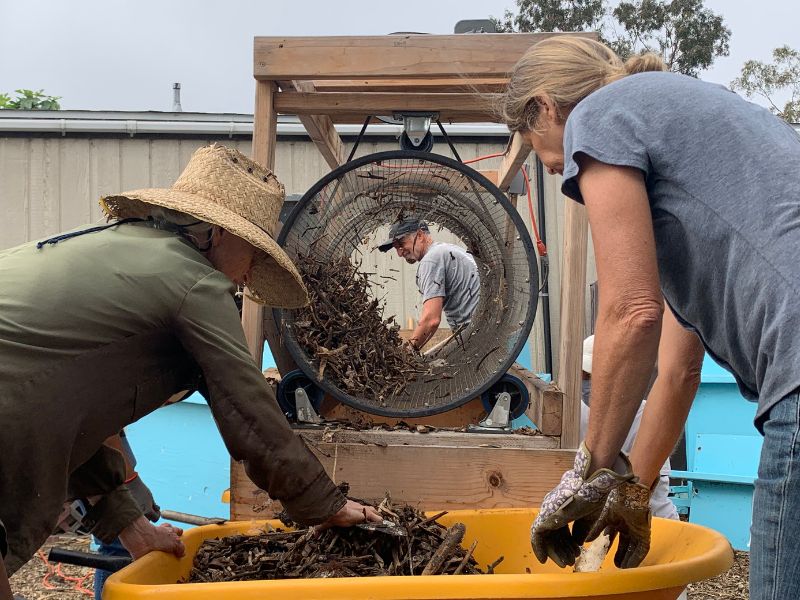Sifting Compost: What a Fine Idea

Our fervent followers may have noticed and supported our recent trommel fundraising campaign for the Food Cycle program. Thanks to generous donations the trommel was fully funded and is now benefiting Food Cycle “tromm”endously. We are extraordinarily grateful.
While our fundraising pitch explained that a trommel can expedite the composting process, we’d like to share what a trommel is, its benefits, and how it works. A trommel is a mechanized tool that screens the smaller pieces of compost from the larger pieces that still need to break down.
Let’s begin with some background.
To create a thriving compost system, we mix the right amount of nitrogen:carbon (greens:browns) and water:air to prepare an ideal diet and environment for decomposing organisms. When the correct ratios are achieved, the decomposition process happens faster.
However, even when most of the materials have been processed by decomposers, there are often pieces that mostly retain their original appearance. This is because all matter decomposes at different rates, largely dependent on two factors. One factor is particle size. Imagine the difference between a log and sawdust: the larger pieces have less surface area compared to their volume which makes it break down at a slower rate. The second factor is the make-up of the cellular composition. Think about how much hardier a tree is than a head of lettuce. This is because brown waste has an abundance of lignin which makes decomposition more difficult. This means that larger, high-carbon pieces like wood chips can remain intact long after most other materials have broken down.
Now let’s discuss the benefits.
This is where trommeling (sifting compost with a trommel) can have a huge impact on creating finished compost for your garden, including:
- A mechanized trommel speeds up the sifting process.
- Trommeling separates the undigested high-carbon matter in the compost which speeds up the curing process. If these pieces are separated from the otherwise-finished compost, the curing time will be greatly reduced and plants will be more likely to thrive in the cured compost.
- Sifting the compost removes rocks and debris like plastics or glass, making a better planting medium without all those lumps and clumps.
- Sifting also aerates the compost, improving the soil structure of your garden beds and allowing for better water penetration.
While it’s not always necessary to sift your compost before spreading it in the garden, Solana Center strives to produce the highest quality compost possible.
How trommeling works at Solana Center.
The new trommel at Solana Center is used for harvesting our Food Cycle’s aerated static piles (ASP). These bins produce about 3 cubic yards of compost every month. This would take an entire day to sift using a backyard wooden sifter. With the help of a motor and gravity, our trommel allows us to screen an ASP in just 2.5 hours.
The trommel design seems simple but it is comprised of a cylinder, a motor, and a large frame. Using old 24” bicycle rims and metal hardware cloth, a 6-foot long tunnel is the main housing for the compost to channel through. A motor and pulley-reduction system makes the large cylinder rotate at a speed of 34 RPMs. The entire thing sits at an angle to have gravity pull materials through, dropping fine materials below and larger materials to the far end and collected in a wheelbarrow. The mechanism is mounted onto a wood frame for easy mobility but extremely sturdy. A lot of thought was put into creating the perfect trommel, and for this we’d like to thank Mike Randall.
After a few months of using this method of harvesting, we have found that about 60% of the debris has broken down to pieces smaller than ½” while the other 40% is added to the next ASP bin for further decomposition.
Now we are able to separate hundreds of pounds of ready-to-cure compost from the bigger bits in record time, and with minimal effort on our part! The labor saved by both staff and volunteers has made a huge dent toward making Food Cycle a more economically sustainable venture that we can continue offering to our community for years to come.
We hope this article has helped you gain a better understanding of the composting process and how sifting and trommeling can benefit it. If you’d like to see our trommel in action, sign up to volunteer at one of our Food Cycle Program Harvest Days. We look forward to seeing you there!
